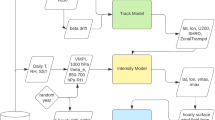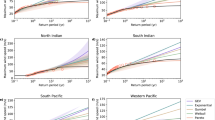Abstract
A method is introduced for assessing the probabilities and intensities of tropical cyclones at landfall and applied to data from the North Atlantic. First, a recently developed model for the basin-wide Monte-Carlo simulation of tropical cyclone tracks is enhanced and transferred to the North Atlantic basin. Subsequently, a large number of synthetic tracks is generated by means of an implementation of this model. This synthetic data is far more comprehensive than the available historical data, while exhibiting the same basic characteristics. It, thus, creates a more sound basis for assessing landfall probabilities than previously available, especially in areas with a low historical landfall frequency.








Similar content being viewed by others
References
Baddeley A, Turner R (2005) \(\tt{spatstat}\): an \(\tt{R}\) package for analyzing spatial point patterns. J Stat Softw 12(6):1–42. URL: http://www.jstatsoft.org
Baddeley A, Gregori P, Mateu J, Stoica R, Stoyan D (eds) (2006) Case studies in spatial point process modeling. Lecture notes in statistics 185. Springer, New York
Demuth J, DeMaria M, Knaff JA (2006) Improvement of advanced microwave sounder unit tropical cyclone intensity and size estimation algorithms. J Appl Meteorol Clim 45:1573–1581
Diggle PJ (2003) Statistical analysis of spatial point patterns, 2nd edn. Arnold, London
Emanuel KA, Ravela S, Vivant E, Risi C (2006) A statistical deterministic approach to hurricane risk assessment. Bull Am Meteorol Soc 87:299–314
Gibbons JD (1985) Nonparametric statistical inference, 2nd edn. Marcel Dekker, New York
Hall TM, Jewson S (2007) Statistical modeling of North Atlantic tropical cyclone tracks. Tellus 59A:486–498
Holland GJ (1980) An analytic model of the wind and pressure profiles in hurricanes. Mon Weather Rev 108:1212–1218
Holland GJ (2007) Misuse of landfall as a proxy for Atlantic tropical cyclone activity. EOS Trans Am Geophys Union 88(36):349–350
Holland GJ, Webster PJ (2007) Heightened tropical cyclone activity in the North Atlantic: natural variability or climate trend? Philos Trans R Soc Lond A 365(1860):2695–2716
Iman RL, Johnson ME, Watson CC (2006) Statistical aspects of forecasting and planning for hurricanes. Am Stat 60(2):105–121
Jarvinen BR, Neumann CJ, Davis MAS (1984) A tropical cyclone data tape for the north Atlantic basin, 1886–1983, contents, limitations and uses. NOAA Tech Memo, NWS NHC 22, Miami
Lehmann EL, Romano JP (2005) Testing statistical hypotheses, 3rd edn. Springer, New York
Mann ME, Emanuel KA (2006) Atlantic hurricane trends linked to climate change. EOS Trans Am Geophys Union 87(24):233, 238, 241
Mayer J, Schmidt V, Schweiggert F (2004) A unified simulation framework for spatial stochastic models. Simul Model Pract Theory 12:307–326
Meyn SP, Tweedie RL (1993) Markov chains and stochastic stability. Springer, London
Munich Reinsurance Company (2006) Hurricanes—more intense, more frequent, more expensive. Insurance in a time of changing risks. Munich, Germany. URL: http://www.munichre.com/publications/302-04891_en.pdf
R Development Core Team (2006) \(\tt{R}\): a language and environment for statistical computing. R Foundation for Statistical Computing, Vienna, Austria
Rumpf J, Rauch E, Schmidt V, Weindl H (2006) Stochastic modeling of tropical cyclone track data. 27th conference on hurricanes and tropical meteorology, April 24–28, 2006, Monterey, CA
Rumpf J, Weindl H, Höppe P, Rauch E, Schmidt V (2007) Stochastic modelling of tropical cyclone tracks. Math Meth Oper Res 66(3):475–490
Silverman BW (1986) Density estimation for statistics and data analysis. Chapman & Hall, New York
Stoyan D, Stoyan H (1994) Fractals, random shapes and point fields. Methods of geometrical statistics. Wiley, Chichester
Stroock DW (2005) An introduction to Markov processes. Springer, Berlin
Acknowledgements
The authors would like to thank two anonymous reviewers for comments and suggestions that helped to improve an earlier version of the manuscript. Furthermore, the authors would like to acknowledge the help of Carolin Rupieper in the mathematical investigation of the point patterns formed by the points of tropical cyclone genesis (see Sect. 2.2).
Author information
Authors and Affiliations
Corresponding author
Rights and permissions
About this article
Cite this article
Rumpf, J., Weindl, H., Höppe, P. et al. Tropical cyclone hazard assessment using model-based track simulation. Nat Hazards 48, 383–398 (2009). https://doi.org/10.1007/s11069-008-9268-9
Received:
Accepted:
Published:
Issue Date:
DOI: https://doi.org/10.1007/s11069-008-9268-9




